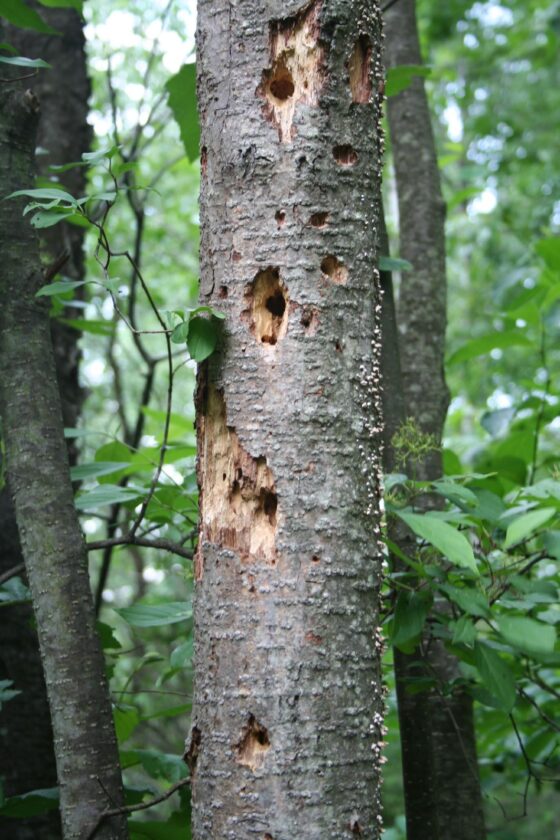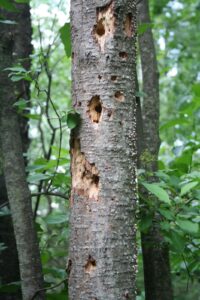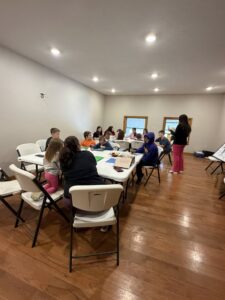Winter exposes troubled trees and bark

Holes left behind by foraging woodpeckers.
The seasons are changing from fall to winter, and one of the major changes to the environment is that the deciduous trees have lost their leaves. Evergreen trees may still have green needles, but all the maples, oaks, and more are now bare. Although the world may be quiet, the trees are not dead, and even without leaves the bark provides a home for all sorts of living things.
Bark is the outer covering of a tree, and just like our skin it protects the tree from infection and disease. Similar to skin, bark is composed of different layers, but the outermost one that you usually see is comprised of dead cells. On the other hand, the inner bark contains living cells that help transport food and water throughout the tree.
In some cases, you can even use the appearance of bark to figure out what kind of tree you are looking at. Some types of tree bark are shaped with strong ridges that run vertically, while others look almost like they are covered in scales. Bark varies in color and can be white, gray, brown, and even reddish.
Although bark itself may not seem interesting at first, it is a resource for a whole host of other creatures, be it plants, animals, and even fungi. Whether it’s being used as a shelter, a food source, or an anchoring point, trees and their bark are valuable parts of the ecosystem.
Some obvious and common denizens of bark are lichen and moss. Mosses are plants that often grow near the base of a tree where the trunk meets the ground, but they can also grow higher up on the trunk and branches. Soft and green, moss likes to grow in damp or shaded areas. Unlike moss, lichens are neither plant nor animal. Instead, they are a unique and complex life form made possible by a symbiotic partnership between fungi and bacteria. Common Greenshield Lichen is often found living on bark, with a light yellow-greenish or green-gray appearance and wrinkled lobes. Mosses and lichens add a splash of color and texture to an otherwise ordinary tree trunk and act as an important winter food source for animals like deer.
In addition to mosses and lichens, there are fungi species that rely almost entirely on trees to grow. At a glance they may look like a nose on the side of the tree or like shelves, hence the common name shelf fungus. These fungi are also known as polypores. The “shelves” are called conks and come in a variety of shapes and sizes. Some species, like the bright yellow-orange Chicken of the Woods, are even edible. With that being said, do not eat any wild mushrooms unless you have an experienced mycologist with you, as many mushrooms have lookalikes that can be toxic.
Also found clinging to bark are vines of other plant species. Watch out for them using a tree trunk as a structure to grow on. You may find grape vines, with spiral shaped tendrils reaching out and clinging onto branches, or poison ivy, with a uniquely hairy appearance.
If you watch closely, especially in the cracks and crevices of bark, you may find insects like ants crawling up and down. You could also find a spider climbing up the trunk, or maybe just remnants of their silk hidden between the crevices in the bark. Not all living things that like tree bark are visible on the surface. Underneath the bark are where bark beetles grow up, carving elaborate paths along the inside of the bark as they eat, which can only be seen if the bark falls off, usually once the tree falls and the logs start to rot.
Holding onto the bark, busy searching for insects like the bark boring beetle, are woodpeckers, whose powerful beaks probe the wood hoping for a delicious snack. Woodpeckers leave behind evidence of their search, from the small dime-sized holes of a Downy Woodpecker to the much larger craters left behind by Pileated Woodpeckers. Yellow-bellied Sapsuckers are a species of woodpecker that, as the name suggests, drink tree sap. They will often move in a circle around the trunk, leaving behind a perfect ring of holes. Listen for the loud tapping noises that accompany a woodpecker on the search for food, and you will likely see one high up in a tree chipping away at the wood.
Beavers are another animal that chew through bark but instead of looking for insects, the bark itself is a food source. Inner bark is full of nutrients and once the beaver finishes their meal, they can chew down the rest of the tree and use it to build their dam. Beaver-chewed trees are usually found near the water where they live; at Audubon you can find stumps left behind around Big Pond Trail.
Although in winter many parts of nature appear to be dead, I encourage you to look at winter trees not as skeletons but as homes for the many other animals, plants, and fungi that live here.
Audubon Community Nature Center builds and nurtures connections between people and nature. ACNC is located just east of Route 62 between Warren and Jamestown. The trails are open from dawn to dusk and birds of prey can be viewed anytime the trails are open. The Nature Center is open from 10 a.m. until 4:30 p.m. daily except Sunday when it opens at 1 p.m. More information can be found online at auduboncnc.org or by calling (716) 569-2345.




